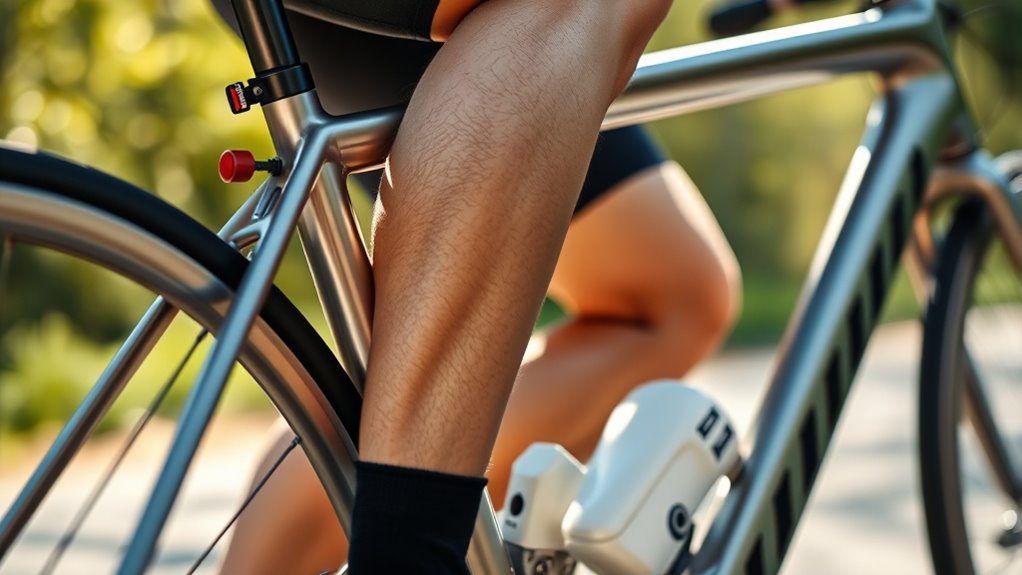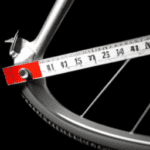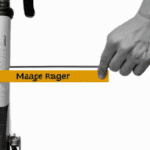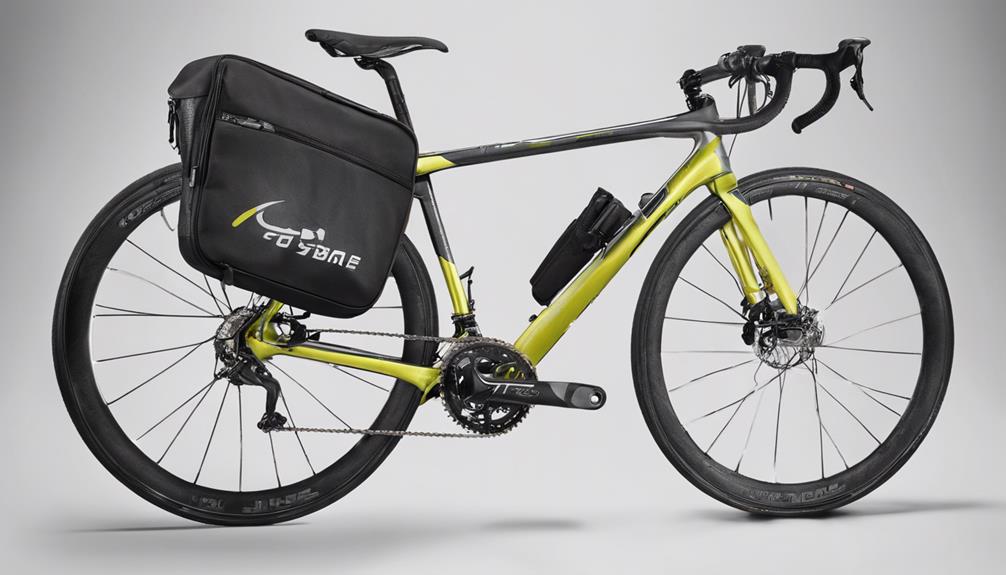Using a saddle height calculator helps you find a personalized, precise saddle position, ensuring better comfort, efficiency, and safety. Avoid guesswork or generic charts, and measure accurately for ideal results. Proper adjustments improve pedaling, reduce discomfort, and prevent injuries like knee pain or back strain. Whether you ride a bike or e-bike, tailoring your saddle height makes a big difference. Keep exploring to learn the best way to optimize your riding setup effectively.
Key Takeaways
- Using a saddle height calculator provides personalized, precise adjustments based on individual measurements, improving comfort and efficiency.
- Proper measurement techniques—such as on a level surface with correct gear—are crucial for accurate saddle height determination.
- Incorporating ergonomic principles and considering riding style ensures optimal saddle positioning for performance and injury prevention.
- Avoid common mistakes like guesswork or ignoring individual biomechanics, which can cause discomfort and reduce riding efficiency.
- Testing and fine-tuning saddle height after initial calculation helps achieve the best fit for comfort and riding goals.
The Importance of Proper Saddle Height for Cyclists and E-Bikers

Having the right saddle height is essential because it directly affects your comfort, efficiency, and safety while riding. When your saddle is properly adjusted, bike maintenance becomes easier because you’re less likely to experience unnecessary wear or strain on your bike parts. Proper saddle height also helps you maintain correct riding posture, reducing fatigue and injury risk. This alignment supports optimal pedaling efficiency, which can improve your overall performance. Proper saddle height also helps you maintain correct riding posture, reducing fatigue and injury risk. This, in turn, enhances your overall cycling experience, whether you’re wearing cycling apparel or casual gear. A well-fitted saddle allows smoother pedaling, improves power transfer, and minimizes discomfort during long rides. Remember, a small adjustment can make a big difference. Investing time in setting your saddle height correctly ensures you’ll ride more efficiently, stay comfortable, and enjoy cycling for years to come.
Common Mistakes When Setting Your Saddle Height
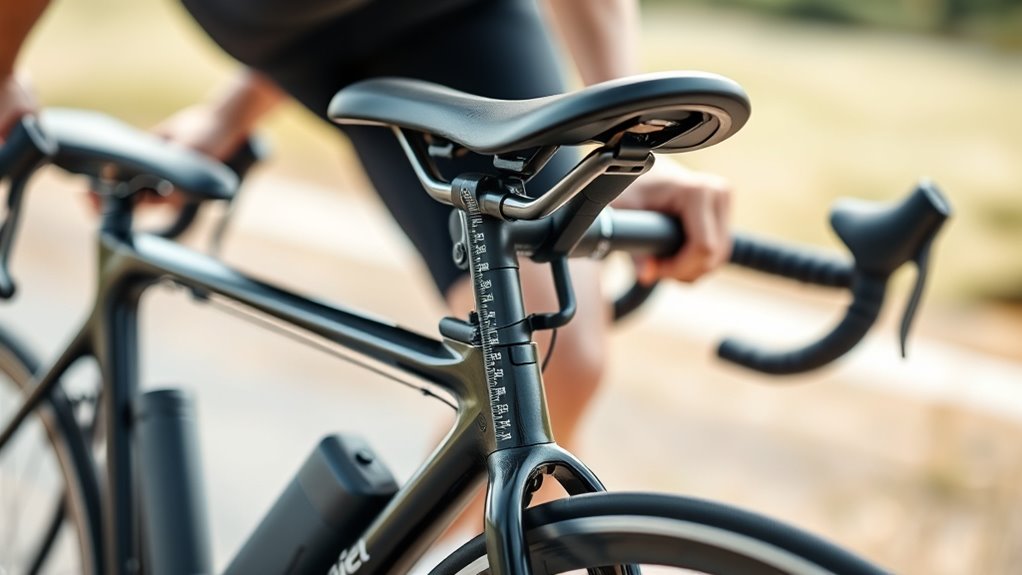
Many cyclists make the mistake of setting their saddle height based solely on guesswork or generic charts, which often leads to discomfort or inefficient pedaling. This neglects important aspects of bike maintenance and rider ergonomics, both essential for peak performance. Raising or lowering your saddle without considering your body’s specific measurements can cause knee pain, back strain, or reduced power transfer. Some riders set their saddle too high, risking instability, while others go too low, limiting pedaling efficiency. Remember, saddle height isn’t a one-size-fits-all setting. Ignoring proper adjustment can lead to longer-term discomfort and even injury. To avoid these common mistakes, pay attention to your body signals, and consider precise measurements rather than relying solely on visual guesses or basic charts. Additionally, understanding ergonomic principles can help ensure your saddle height promotes comfort and efficiency during rides.
How a Saddle Height Calculator Simplifies Your Adjustment Process

A saddle height calculator makes it easy to find your perfect fit quickly. It provides precise adjustments based on your measurements, reducing guesswork. As a result, you save time and get back on your bike faster with confidence.
Precise Fit Adjustment
A saddle height calculator makes achieving the perfect fit straightforward by providing precise measurements tailored to your body and riding style. This tool helps you fine-tune your saddle position, guaranteeing ideal comfort and efficiency. When adjusting, consider bike frame compatibility to ensure the saddle aligns correctly with your bike’s geometry. Additionally, saddle material considerations influence how you fine-tune height, as softer materials may require slight adjustments for comfort. Use this table to understand key factors:
| Factor | Impact |
|---|---|
| Bike frame compatibility | Ensures saddle height suits your bike’s geometry |
| Saddle material considerations | Affects comfort and subtle height adjustments |
| Precise measurement | Provides accurate, personalized fit |
– Incorporating ergonomic principles can further enhance your saddle height adjustment process, ensuring optimal comfort and performance.
This approach simplifies adjustments, leading to a more effective ride.
Time-Saving Technique
Using a saddle height calculator streamlines the adjustment process by providing instant, accurate measurements tailored to your body and riding style. This tool saves you time on bike maintenance and helps you avoid trial-and-error adjustments. With precise saddle height data, you can quickly optimize your riding techniques, leading to better comfort and efficiency. Instead of manual measurements or guesswork, the calculator offers reliable results in moments. It’s especially helpful when setting up multiple bikes or making frequent adjustments. By simplifying the process, you spend less time fiddling and more time riding. Plus, it minimizes the risk of improper saddle height, reducing discomfort and potential injury. Additionally, integrating AI technology can further enhance the accuracy and personalization of your saddle adjustments. Overall, a saddle height calculator makes fine-tuning your bike faster, easier, and more accurate, so you get the most out of every ride.
Step-by-Step Guide to Using a Saddle Height Calculator Effectively
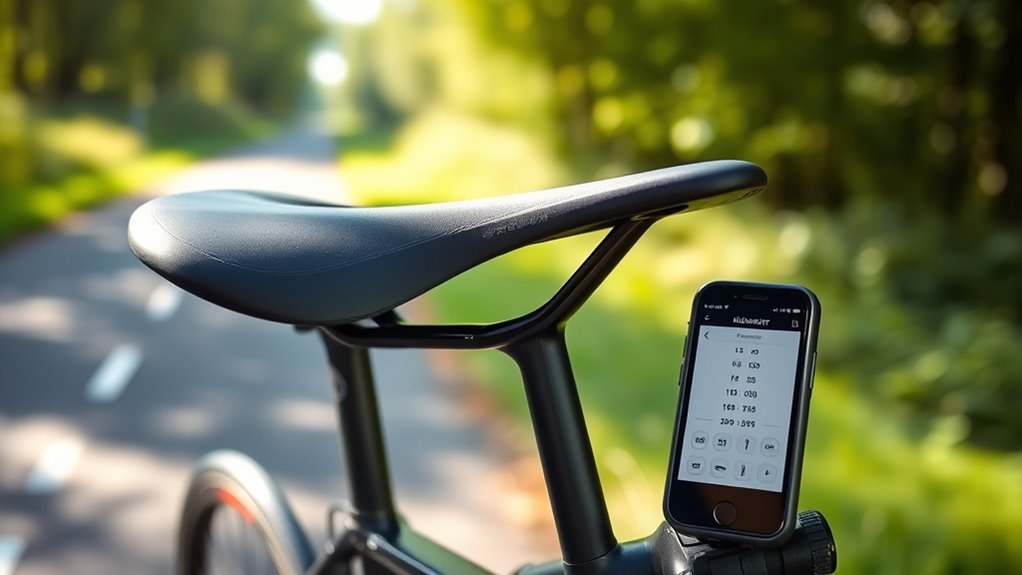
To get the best results, start by preparing your measurements accurately. Then, input your data carefully into the calculator, making sure it’s precise. Additionally, consider the motor power output of your bike or conversion kit, as it can influence your saddle height adjustments for optimal comfort and performance. Finally, adjust your saddle height for comfort, using the calculator’s recommendations as a starting point.
Prepare Your Measurements
Before you start measuring, make sure you’re wearing your cycling shoes and have a flat, level surface to work on. Accurate measurements are essential for proper bike ergonomics and comfort. To prepare, consider the saddle materials that suit your riding style, as they affect comfort during long rides. Keep these tips in mind:
- Remove any bulky clothing or accessories.
- Use a sturdy tape measure or ruler.
- Find a mirror or have someone assist you for precise measurements.
- Ensure your bike is properly adjusted to your height.
- Relax your muscles to get natural, consistent measurements.
- Remember that bike fitting adjustments can significantly improve your riding experience and comfort.
Input Accurate Data
Gathering your accurate measurements is the key to setting your saddle height correctly. When inputting data into the calculator, focus on precision to optimize bike ergonomics. Verify your measurements reflect your current riding position, as small errors can lead to discomfort or inefficient pedaling. Take note of your inseam, leg length, and saddle height preferences. Be mindful of saddle materials; some materials may affect your comfort and position, so account for any padding or firmness differences. Double-check your measurements before entering them, avoiding guesswork. Accurate data helps the calculator provide a tailored saddle height that promotes better cycling posture and performance. Remember, precise input is essential for achieving the best fit and ensuring your ride is comfortable and efficient. Additionally, understanding home furnishings related to comfort, such as supportive mattresses or cushions, can enhance your overall riding experience by improving rest and recovery.
Adjust for Comfort
Ever wonder how to make your saddle height feel just right for your comfort? Adjusting your saddle height isn’t just about numbers; it’s about feeling good during every ride. Start by considering your saddle material—soft or firm saddles can affect comfort, so tweak height accordingly. Use saddle accessories like gel covers or padding to add extra cushioning if needed. Remember, small adjustments can make a big difference—raise or lower your saddle gradually. Pay attention to your riding posture and how your hips, knees, and back feel. Don’t forget to test your setup on a short ride, and fine-tune as necessary. Comfort isn’t one-size-fits-all, so use these tips to personalize your saddle height for a smoother, more enjoyable ride. Incorporating professional equipment can also improve recording quality and help you achieve a more precise adjustment process.
The Science Behind Accurate Saddle Positioning
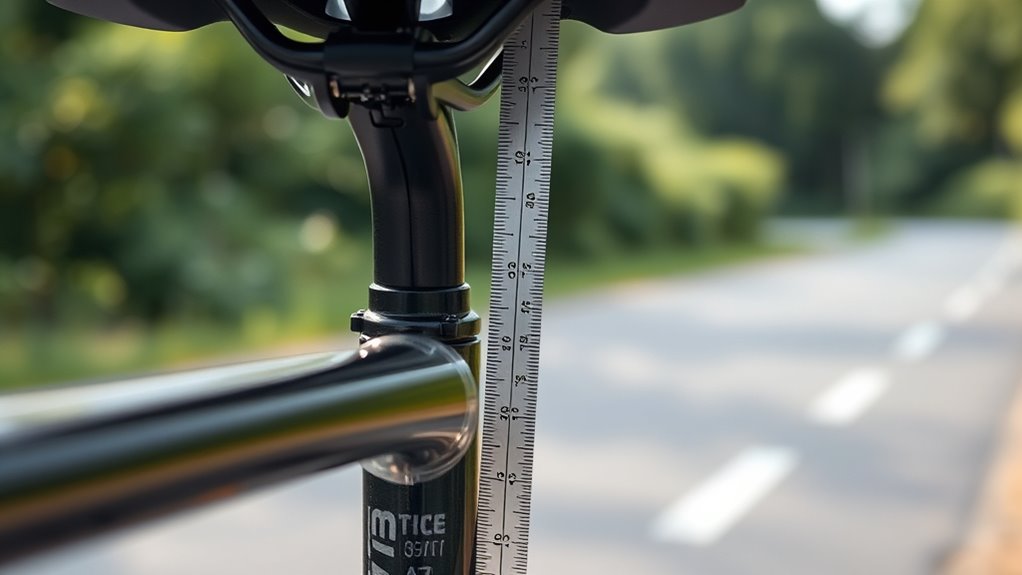
Understanding the science behind accurate saddle positioning is essential because it directly impacts your comfort, efficiency, and injury prevention while cycling. Proper saddle height aligns with biomechanical principles, ensuring your joints move naturally and reduce strain. When you position your saddle correctly, you gain ergonomic benefits like improved posture and reduced muscle fatigue. This suitable alignment helps distribute your weight evenly, minimizing pressure points and preventing overuse injuries. The science shows that minor adjustments can considerably affect your pedaling efficiency and overall ride quality. By applying biomechanical principles, you ensure your body maintains proper support and alignment throughout your ride. Additionally, understanding the environmental impact of cycling practices can motivate more sustainable riding habits, such as optimizing saddle height to maximize efficiency and reduce unnecessary exertion. This scientific understanding empowers you to find the ideal saddle position, enhancing both comfort and performance on every ride.
Signs You Might Be Riding With an Incorrect Saddle Height

If your saddle height isn’t set correctly, you’ll likely notice discomfort or inefficiency during your rides. You might experience persistent knee pain, especially when pedaling, or feel unstable and unbalanced on the bike. Poor saddle height can also cause you to overreach or strain your back, leading to fatigue. Additionally, if your saddle is too high, your hips may sway side to side, reducing power transfer. You might also struggle to maintain a steady cadence or find cycling apparel feeling uncomfortable. Signs like these indicate your saddle height needs adjusting. Keep in mind, the right bike accessories, like padded shorts or ergonomic grips, can help improve comfort once your saddle is correctly set. Monitoring these signs ensures a smoother, more enjoyable ride. Proper saddle height can also influence your overall cycling performance and efficiency.
Adjusting Your Saddle Height for Different Riding Styles

Adjusting your saddle height to match different riding styles can considerably improve your comfort and performance. Your bike frame geometry influences how you set your saddle, as some frames are designed for aggressive, aerodynamic riding, while others favor relaxed positions. For mountain biking or casual rides, you might prefer a slightly higher saddle for better power transfer or a lower one for stability. Consider saddle padding options, as thicker padding can reduce pressure on sensitive areas during longer or more relaxed rides, while firmer saddles suit aggressive styles. Always fine-tune your saddle height based on your riding goals, ensuring your hips remain stable and your pedaling efficiency stays ideal. Proper adjustment aligns with your bike’s geometry and riding style, maximizing comfort and performance.
Benefits of Precise Saddle Adjustment for Comfort and Performance
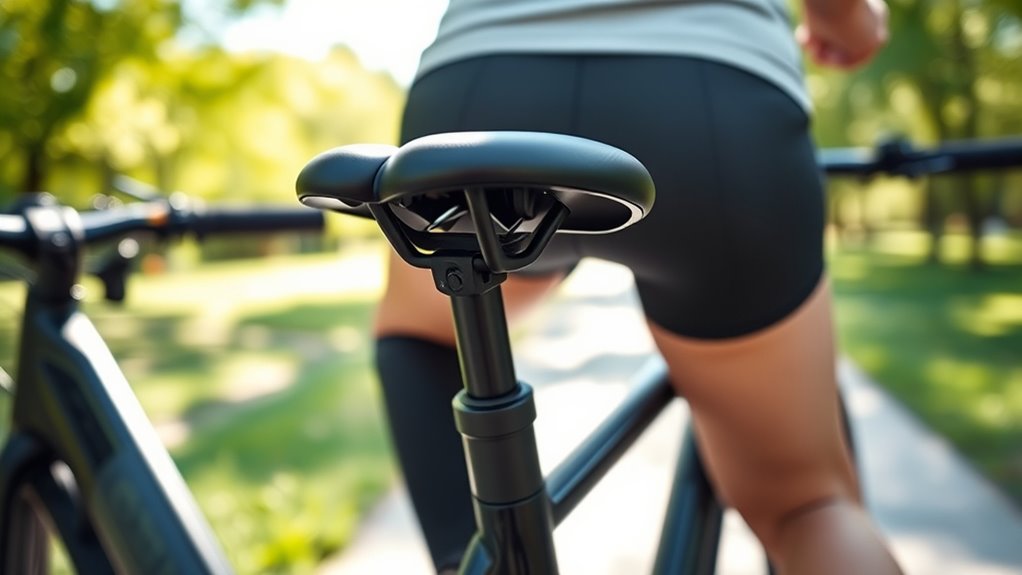
Properly setting your saddle height directly enhances both comfort and performance by ensuring efficient pedaling and reducing strain. When your saddle is precisely adjusted, you experience smoother power transfer, less fatigue, and better control. This improves your overall ride quality and helps prevent injuries. Additionally, proper saddle height makes bike maintenance easier, as it minimizes wear on components. It also allows you to wear cycling apparel comfortably without restrictions. A well-fitted saddle encourages better posture, reducing back and knee pain. You’ll notice increased confidence on the bike and improved endurance over long distances. Ultimately, precise saddle adjustment supports your riding goals, whether for casual rides or intense training. It’s a simple tweak that brings significant benefits for comfort and performance.
Frequently Asked Questions
Can Saddle Height Affect My Overall Cycling Efficiency?
Yes, saddle height affects your cycling efficiency. When set correctly, it promotes an ergonomic design that minimizes fatigue and maximizes power transfer. If your saddle is too high or low, it can cause discomfort and reduce your pedaling effectiveness. Also, consider saddle materials; a comfortable, well-designed saddle enhances your ride’s efficiency by reducing pressure points and allowing you to maintain proper posture throughout your ride.
How Often Should I Recheck My Saddle Height?
Think of your bike fitting as a tailor-made suit; it needs regular adjustments to stay perfect. You should recheck your saddle height every 1 to 3 months or whenever you notice discomfort, changes in flexibility, or after a long ride. This keeps your comfort optimization on point and prevents unnecessary strain. Consistent checks guarantee your saddle height remains aligned with your evolving body and riding style.
Is a Digital or Manual Calculator More Accurate?
A digital calculator generally offers more accuracy because it incorporates advanced measurement tools and ergonomic design features. You benefit from precise readings and easier adjustments, especially if you’re using tools that account for your specific body measurements. Manual calculators can work well but might lack the fine-tuned precision. For the best results, opt for a digital option, as it leverages modern measurement tools to guarantee your saddle height is perfectly suited to your body.
Do Saddle Height Adjustments Differ Between Road and Mountain Bikes?
Yes, saddle height adjustments differ between road and mountain bikes because of their unique riding positions and frame sizes. You’ll need to set your seat post height based on the bike’s frame size for ideal comfort and efficiency. Mountain bikes often require slightly lower saddle positions for better control on rough terrain, while road bikes benefit from a higher saddle for maximum power and efficiency. Always tailor adjustments to your riding style.
Can Improper Saddle Height Cause Long-Term Injuries?
Improper saddle height can lead to long-term injuries if you ignore ergonomic comfort and injury prevention. If your saddle is too high or low, you might strain your knees, hips, or lower back, causing chronic pain or joint issues. Ensuring your saddle height is correct promotes proper biomechanics, reduces fatigue, and prevents injury over time. Regular adjustments and listening to your body are key to maintaining safe, comfortable cycling.
Conclusion
Getting your saddle height just right transforms your ride from a blur of discomfort to a smooth glide through the wind. Picture yourself effortlessly cruising, your legs perfectly extended, and your back relaxed. With a saddle height calculator guiding your adjustments, you’ll feel confident each time you hit the road or trail. Remember, a properly set saddle isn’t just about comfort—it’s your secret weapon for better performance and endless miles of enjoyable riding.
